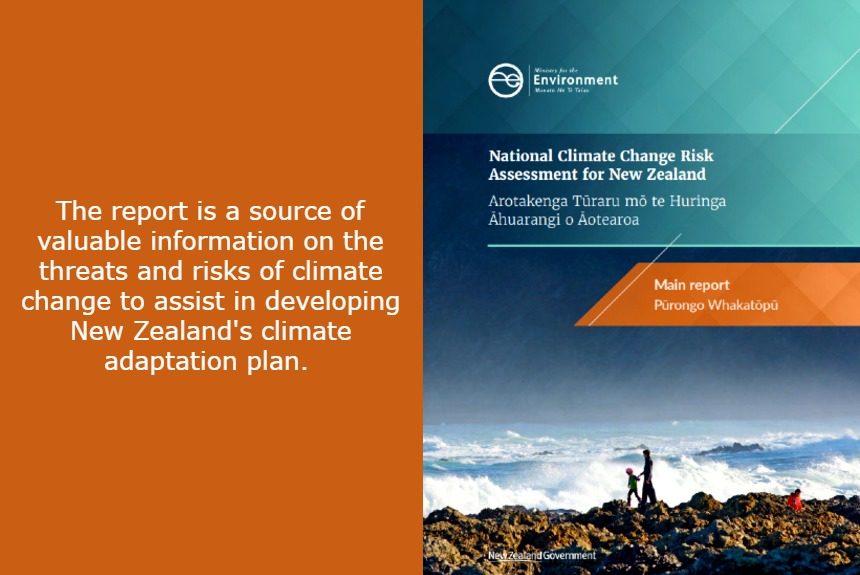The MTE’s (Ministry of the Environment) report, National Climate Change Risks Assessment for New Zealand (NCCRA), presented the risks faced by the country from climate change. Experts and practitioners in the inquiry laid out these climate risks under five domains: natural environment, human, economy, built environment, and governance. Findings from this report will form the basis of the country’s climate adaptation plan.
Why this inquiry? The message is clear – “New Zealand’s climate is warming, sea levels are rising, and extreme weather events are becoming more frequent and severe,” and its consequences are affecting New Zealand (National Climate Change, 2020).
For instance, the temperature has increased by 1°C in the last 100 years, will rise another degree by 2040, and 3 degrees in 2090. The sea level has risen by 2.44mm per year over the past 60 years. It will increase a further 0.21m by 2040 and 0.67 by 2090. Northland will experience more extreme rainfall, cyclones, frost, and snow days will decrease, and the number of dry days will increase for the whole country. Drought will be more frequent on the east side of the South Island. Wildfires will increase due to higher temperatures and wind speeds, but there will be a decrease in rainfall and humidity (National Climate Change, 2020).
In addition to evaluating the climate change risks, the report has uncovered information gaps that would need further research and opportunities from the changing climate.
The report has classified climate risks according to their urgency and severity to prioritise response. It highlighted the top ten most significant climate change risks, consisting of two topmost risks from each domain.
The built environment requires urgent action
The findings revealed the top ten most significant climate change risks according to urgency and consequence, two from each domain. From the top ten climate risks, the built environment stands out as the domain that requires urgent action with “extreme” consequences. This built environment refers specifically to potable water supplies and infrastructures such as landfills, wastewater and stormwater systems, ports, linear transport networks, airports, and electricity infrastructure vulnerable to climate change. This is discussed thoroughly in section 5.6 of the report (National Climate Change, 2020).
National Climate Change (2020) presents the following findings:
- Risks to the economy follow the built environment due to lost productivity, disaster relief costs, unfunded liabilities due to extreme weather, and ongoing climatic changes.
- Projections of severe droughts will reduce water availability. Water demands will increase due to population growth in these regions – Auckland, Bay of Plenty, Northland, Waikato, Greater Wellington, Hawkes’s Bay, and Otago, which will add more pressure to water supplies.
- Recent droughts have caused water shortages in Waikato, Auckland, and Northland. This has caused many water restriction advisories, first for public use of water followed by residential use in gardening and other residential and commercial purposes depending on the level of water supply shortage.
- The rise in sea level and increases in heavy rainfall are already affecting the water quality around the country. For example, in March 2017, Auckland’s three intense rainstorms caused sedimentation and contamination in its dams that supply water to the city and surrounding areas.
- The report also discusses the country’s adaptive capacity to cope with each risk. In New Zealand, the local authorities or organisations are controlled by councils that manage and supply water to the local area.
- To improve the country’s adaptive capacity, the central government is doing a Three Waters Review to create a new regulatory body for a drinking water system. It aims to improve the adaptive capacity and resilience of the water supply system to climate change. The cost needed to upgrade water and wastewater infrastructure in New Zealand is estimated at $8 billion.
The report is a source of valuable information on the threats and risks of climate change to assist in developing New Zealand’s climate adaptation plan. This information can also benefit the local communities by helping them better understand climate change impacts.
Dissemination of the data to local communities using clear everyday language will help them prepare for climate change and encourage their involvement and cooperation in developing climate actions and responses.
Read the full report by clicking on the button below.
Source:
National Climate Change Risk Assessment for New Zealand, Main report. (2020, August). Ministry for the Environment. Retrieved from https://www.mfe.govt.nz/sites/default/files/media/Climate%20Change/national-climate-change-risk-assessment-main-report.pdf



Leave a Reply